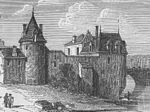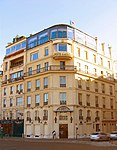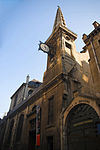Institut du Monde Arabe
Arab organizationsArabs in FranceBuildings and structures in ParisBuildings and structures in the 5th arrondissement of ParisIslamic museums ... and 3 more
Jean Nouvel buildingsMuseums in ParisResearch institutes established in 1980

The Institut du Monde Arabe, French for Arab World Institute, abbreviated IMA, is an organization founded in Paris in 1980 by France with 18 Arab countries to research and disseminate information about the Arab world and its cultural and spiritual values. The Institute was established as a result of a perceived lack of representation for the Arab world in France, and seeks to provide a secular location for the promotion of Arab civilization, art, knowledge, and aesthetics. Housed within the institution are a museum, library, auditorium, restaurant, offices and meeting rooms.
Excerpt from the Wikipedia article Institut du Monde Arabe (License: CC BY-SA 3.0, Authors, Images).Institut du Monde Arabe
Rue des Fossés Saint-Bernard, Paris 5th Arrondissement (Paris)
Geographical coordinates (GPS) Address Phone number Website External links Nearby Places Show on map
Geographical coordinates (GPS)
| Latitude | Longitude |
|---|---|
| N 48.848903230556 ° | E 2.3570409694444 ° |
Address
Institut du Monde Arabe
Rue des Fossés Saint-Bernard 1
75005 Paris, 5th Arrondissement (Paris)
Ile-de-France, France
Open on Google Maps









